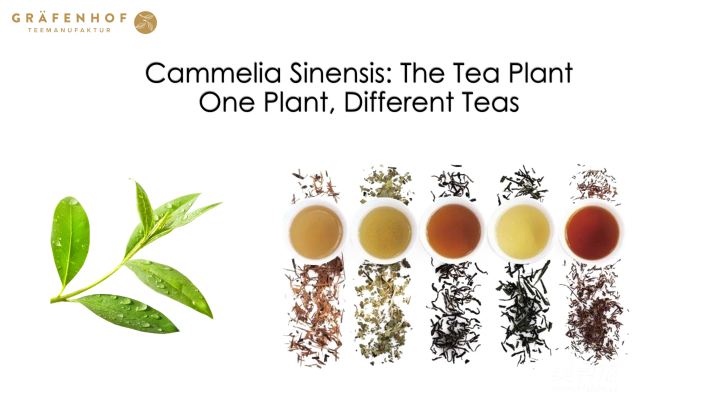Camellia sinensis: the tea plant.
Camellia sinensis is the official name for the tea plant.
The properties and especially the taste of the plant varies depending on the origin. The origin has an incredibly large influence on the end product.
The best known are Camellia sinensis var. sinensis and Camillia sinensis var. assamica.
Camellia sinensis var. sinensis grows in China, Japan and Taiwan. It has adapted to the high altitudes and the cool to frosty, climate. This results in a light and fresh to a full and malty flavor.
Camellia sinensis var. assamica, on the other hand, grows in more tropical regions such as India, Sri Lanka and Kenya. There, the climate is much more humid and hotter. Its flavor varies from strong malty to soft and grassy green.
The tea plant can produce a wide variety of teas. Depending on how it is processed, five types of tea can be developed from its leaves.
The best known type is probably green tea. After harvesting, the leaves are first fixed, i.e. the enzymes that could cause fermentation are destroyed. Then the leaves are rolled and roasted or dried. At the end they are still sorted.
In the case of black tea or oolong tea, after harvesting, there is a process of withering before the leaves are rolled. Then they are fermented. One speaks of fermentation when the leaves are spread out in a humid environment. Actually, one should speak of oxidation, but with tea it is called fermentation. Afterwards, the leaves are roasted or dried and sorted, as is the case with green tea.
For white tea, the leaves are left to wilt after harvesting and then roasted or dried. These leaves are also sorted at the end.
If you want to make pu-erh tea, you let the leaves wilt after harvesting and then roll them after the process of wilting. After that, the leaves are pressed together to form tea bricks. They are left to ripen in this brick form. Depending on how long the bricks are matured, the taste varies. In the end, the bricks are roasted or dried.
Yellow tea is drunk almost exclusively in China and is hardly produced for the world market. As with green tea, the leaves are first fixed and rolled after harvest. Next, they are wrapped in a damp cloth. So the leaves rest for a while. At the end, they are sorted.
Translated with www.DeepL.com/Translator (free version)
